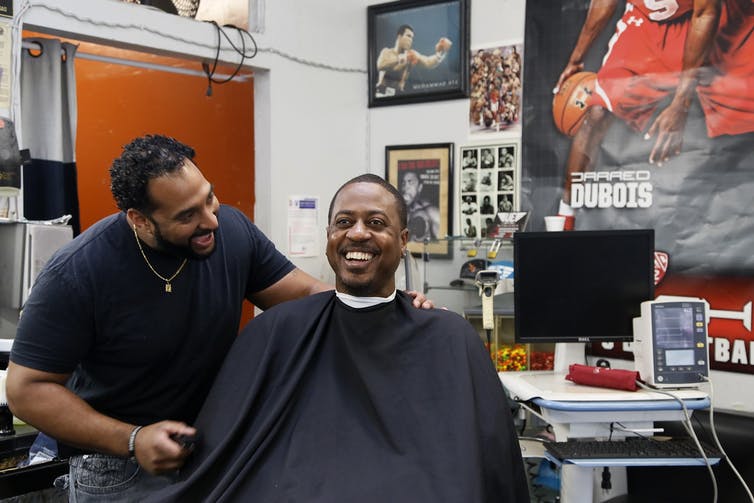As Italy’s death toll from the novel coronavirus climbed to one of the highest in the world, its doctors made a plea to other countries: Manage the pandemic in the community, not in hospitals and emergency rooms.
When people with COVID-19 show up at hospitals, they can spread the virus to other patients and health care workers. Italian authorities believe that the instinct to go to the emergency room first, even when the symptoms aren’t severe, contributed to the country’s current disaster.
Like Italy’s, the United States’ health system is hospital-centered. As a result, pandemics can quickly overwhelm the hospital system, limiting its capacity to deal with other urgent medical conditions.
But an alternative exists that could help manage the pandemic among the majority of COVID-19 patients with mild or moderate symptoms. It is the 67,000 community pharmacies in the U.S., whose numbers dwarf the 5,500 hospitals and 1,400 community health centers. They are staffed by 175,000 pharmacists frequently referred to as the most overtrained and underutilized health care professionals in America.
As a clinical pharmacist and a professor of pharmacy at the University of Southern California, I’ve seen firsthand how much health care pharmacists can deliver and what they could bring to the fight against the coronavirus.
Pharmacies becoming coronavirus test sites
Many pharmacies already offered testing for streptococcal and influenza infections, but it wasn’t until April 8 that U.S. pharmacies were authorized to order and administer COVID-19 tests.
Pharmacists are now positioned to broadly perform testing that will provide vital data as public health professionals strategize how best to slow the virus’s spread. Testing is an established tactic for significantly reducing the size of an infectious disease outbreak. Widespread testing for the coronavirus in countries including China, South Korea, Singapore and Germany and the subsequent isolation of infected patients appear to be common factors in containing the spread and limiting deaths from the disease.
But offering testing is just one step. Pharmacists have the knowledge to do more on the front lines of a pandemic. They are trained side by side with physicians and nurses, and many complete postgraduate residencies and fellowships.
Projects show pharmacists’ potential impact
In a number of programs across the county, pharmacists have shown that they can dramatically improve control of medical conditions, avoid the need for hospital admissions and reduce health care costs.
When pharmacists in Los Angeles teamed up with barbershops to manage high blood pressure for black patients, nearly 90% of the patients reached their blood pressure target, compared to only one-third of patients who received traditional medical care.

AP Photo/Damian Dovarganes
In Kern County, California, another program had pharmacists contact 1,100 fragile Medicaid patients shortly after they were released from hospitals to ensure they were taking their medications correctly. The patients’ hospital readmissions rate dropped by 32%, saving an average of US$2,139 per patient.
A University of Southern California study demonstrated that patients whose diabetes medications were managed by a pharmacist were three times more likely to reach their blood sugar targets.
First point of contact for COVID-19?
In the case of COVID-19, pharmacists could be a first point of contact for people who suspect they have been infected but aren’t seriously ill.
With the proper precautions, pharmacists can offer drive-up testing and evaluation services that allow patients to remain in their cars, and they can provide selective home visits for those who are quarantined or self-isolated. Pharmacists can also refer patients for further medical care when needed.
Why wasn’t all this already happening on a wide scale? Why did it require the Public Readiness and Emergency Preparedness Act, brought on by the current pandemic?
The reason is pharmacists are not recognized by the federal government as health care providers. As a result, they do not have access to Medicare and Medicaid reimbursement codes for providing medical services beyond filling prescriptions. This means they cannot be paid by the government or insurance companies for patient care services that they have the training to provide. Without the recent authorization from the U.S. Department of Health and Human Services, pharmacists would not have been able to perform COVID-19 testing.
Pharmacists are trained to ensure that over 10,000 prescription drugs are used properly. Advanced services, such as comprehensive medication management, provide an individualized evaluation, and pharmacists providing CMM can adjust medications in partnership with physicians and follow up with patients until treatment goals are reached. With strong links between common diseases, such as high blood pressure, diabetes and asthma, and complications from COVID-19, these services are more important then ever.
COVID-19 has created new and unprecedented challenges for our health care system. With more than 90% of the U.S. population within 5 miles of a pharmacy, pharmacists are well-situated to step in to help beat this national crisis.

